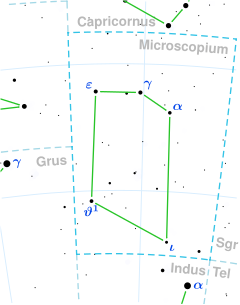| Observation data Epoch J2000 Equinox J2000 | |
|---|---|
| Constellation | Microscopium [1] |
| Right ascension | 20h 40m 19.82792s [2] |
| Declination | −33° 25′ 54.6462″ [2] |
| Apparent magnitude (V) | 5.47±0.01 [3] |
| Characteristics | |
| Evolutionary stage | red giant branch [4] |
| Spectral type | K1 III [5] |
| U−B color index | +1.08 [6] |
| B−V color index | +1.12 [6] |
| Astrometry | |
| Radial velocity (Rv) | 14.2±2.8 [7] km/s |
| Proper motion (μ) | RA: +21.953 mas/yr [2] Dec.: +34.487 mas/yr [2] |
| Parallax (π) | 13.5581±0.0691 mas [2] |
| Distance | 241 ± 1 ly (73.8 ± 0.4 pc) |
| Absolute magnitude (MV) | +1.17 [1] |
| Details | |
| Mass | 1.4±0.1 [8] M☉ |
| Radius | 11.5 [9] R☉ |
| Luminosity | 43.7+3.1 −2.9 [10] L☉ |
| Surface gravity (log g) | 2.46±0.34 [11] cgs |
| Temperature | 4,681±122 [12] K |
| Metallicity [Fe/H] | −0.02 [13] dex |
| Rotational velocity (v sin i) | <1 [14] km/s |
| Age | 3.4±0.6 [8] Gyr |
| Other designations | |
| 13 G. Microscopii [15] , CD−33°15119, CPD−33°5922, FK5 1540, GC 28776, HD 196737, HIP 102014, HR 7893, SAO 212333 [16] | |
| Database references | |
| SIMBAD | data |
HD 196737, also designated as HR 7893, is a solitary orange hued star [17] located in the southern constellation of Microscopium. It has an apparent magnitude of 5.47, [3] allowing it to be faintly visible to the naked eye. The object is located relatively close at a distance of 241 light years based on Gaia DR3 parallax measurements, [2] but is receding with a heliocentric radial velocity of 14.2 km/s . [7] At its current distance, HD 196737's brightness is diminished by 0.14 magnitudes due to interstellar dust. [18] It has an absolute magnitude of 1.17. [1]
This is an evolved giant star with a stellar classification of K1 III. [5] HD 196737 is estimated to be 3.4 billion years old based on asteroseismologic measurements, [8] enough for it to cool and expand onto the red giant branch; it is now fusing a hydrogen shell around an inert helium core. [4] It has 1.4 time the mass of the Sun [8] and an enlarged radius of 11.5 R☉. [9] It radiates 43.7 times the luminosity of the Sun [10] from its photosphere at an effective temperature of 4,681 K . [12] HD 196737 has a solar metallicity — what astronomers dub chemical elements heavier than helium. The star has a projected rotational velocity too low to be measured accurately. [14]
